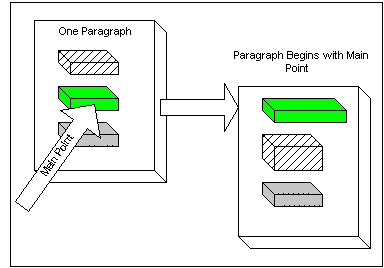|
| Structure | Tips | Theory | WebPoems | Workshops | Books | Articles | Lisa | Jonathan |
Tips |
Put the idea of the paragraph first. |
|
 Background: Background:
Several participants, while scanning text, would read only the first sentence of the paragraph. This suggests that topic sentences are important, as is the "one idea per paragraph" rule. —Morkes & Nielsen (1997) Lets users decide whether to read or skip. —Frisse (1987) Helps accurate comprehension. —Kieras (1980) A topic sentence states the controlling idea of a paragraph; the rest of the paragraph supports and develops that statement with carefully related details. The topic sentence is often the first sentence because it states the subject the paragraph is to develop. The topic sentence is effective in this position because the reader knows immediately what the paragraph is about. —Brusaw et al. (1997) Original Paragraph:Sometimes we go through a lengthy period of preparation, during which we gather information, think about the problem, and, perhaps, try out some preliminary solutions. You have probably observed yourself doing this on school projects. Much early work on the way we think was similarly based on self-observation. In 1926, for example, Wallas published his classic The Art of Thought, in which he summarized his reflections on the way he himself thought that he thought—and backed up those introspective analyses with autobiographical narratives by other people. He saw four major phases to thinking. You might be interested to know that after the preparation phase came:
145 words. Revised Paragraph:Much early work on the way we think was based on self-observation. In 1926, for example, Wallas published his classic The Art of Thought, in which he summarized his reflections on the way he himself thought that he thought—and backed up those introspective analyses with autobiographical narratives by other people. He saw four major phases to thinking:
113 words. Challenge: Carve into paragraphs, each starting with a topic sentence describing its main idea. Polya stresses the importance of restating the goal (working back from what you want to achieve to the materials given) and restating the givens (working forward from what you are given to the goal). Of course, because these ideas are too vague to test experimentally, we cannot call his work empirically based, although it does, of course, derive from his many years teaching students to solve geometric and mathematical problems. He sketches out four steps in How to Solve It (1957):
You can see that Polya’s first step, in which you endeavor to understand the problem, corresponds roughly to Wallas’ preparation. But part of devising the plan corresponds to that phase, as well, but includes what Wallas calls incubation and illumination, too. Looking back corresponds closely to Wallas’ verification. Without careful experiments, we cannot say for sure that either description is accurate, because both are subjective; our intuition agrees with both descriptions, but science expects more of us than hunches. So Polya ends up being, simply, another example of the introspective approach—suggestive, but not scientifically validated. Polya’s emphasis on rearranging our view of the givens or goal, though, resembles Gestaltian restructuring. |
Other tips on making your prose easier to scan:
|
|
| List of web sites, research articles, and textbooks used to develop the tips. |
Services/Tips/Theory/WebPoems/Workshops/Books/Articles/Lisa/Jonathan
Copyright 1998 Jonathan and Lisa Price, The Communication Circle
Return to our site at http://www.theprices.com
Email us at JonPrice@AOL.com